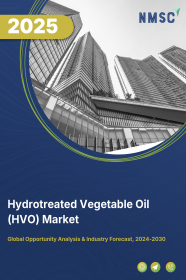
Hydrotreated Vegetable Oil (HVO) Market by Feedstock Type, (Virgin Vegetable Oil, Waste And Residual Oils, Animal Fats, Advanced Bio-feedstocks, Others), by Production Process, (Dedicated Hvo Plants (hefa/ecofining), Co-processing In Petroleum Refineries, Fischer-tropsch/gasification), by Quality/certification, (En 15940 Paraffinic Diesel, Astm D975 Renewable Diesel, Iscc/eu‑red Ii Certified, Other National Standards) – Global Opportunity Analysis and Industry Forecast, 2024 – 2030
Market Definition
The global Hydrotreated Vegetable Oil (HVO) Market size was valued at USD 20.82 billion in 2023 and is predicted to reach USD 51.93 billion by 2030 with a CAGR of 14% from 2024-2030. Hydrotreated Vegetable Oil (HVO) is a renewable and sustainable alternative to traditional diesel fuel derived from plant-based sources such as vegetable oils or animal fats. It undergoes a hydrotreatment process, which removes impurities and reduces the oxygen content, resulting in a high-quality, low-emission diesel substitute that can be used in existing diesel engines.
HVO works by subjecting the feedstock, often vegetable oils or animal fats, to a hydrogenation process under high temperature and pressure. This process eliminates unwanted compounds such as oxygen and sulphur, resulting in a cleaner-burning, more energy-dense fuel that can be seamlessly integrated into conventional diesel engine systems.
The advantages of HVO include its reduced greenhouse gas emissions, as it produces significantly lower carbon dioxide and particulate matter when burned compared to traditional diesel fuels. It also boasts excellent cold-weather performance and can be used without any engine modifications, making it a viable and environmentally friendly alternative in the transition towards more sustainable transportation solutions.
Market Dynamics and Trends
Increasing global demand for sustainable and renewable fuel by industries to reduce carbon emissions and achieve environmental sustainability is fuelling the adoption of hydrotreated vegetable oil, in turn driving the growth of the market. Hydrotreated vegetable oil (HVO) is as an eco-friendly alternative to traditional diesel and fossil fuels, which involves the hydrotreatment of vegetable oils, results in a cleaner-burning, low-carbon fuel that significantly reduces greenhouse gas emissions.
Moreover, stringent environmental regulations and policies mandating the reduction of greenhouse gas emissions are further driving the adoption of HVO. Several countries such as the U.S., Sweden, Norway, Finland, and Franch have implemented policies to incentivize or require the use of biofuels such as HVO in transportation and industrial sectors. For instance, the European Union implemented a policy known as the Renewable Energy Directive (RED II), which sets an overall European renewable energy target of 32% by 2030. This policy also aims to increase the share of renewables in the transport sector, thereby expected to boost the hydrotreated vegetable oil market.
Additionally, various jurisdictions around the world have established emission reduction targets that encourage the use of HVO and other renewable fuels. However, the high production costs associated with HVO can make it less competitive with traditional fossil fuels, hindering its widespread adoption, especially in regions where cost is a significant factor.
On the contrary, the use of waste cooking oil, algae, and other biomass sources as a diverse HVO feedstock is expected to reduce production costs and improve the sustainability profile of HVO, creating ample opportunities for the market in the coming years.
Market Segmentations and Scope of the Study
The hydrotreated vegetable oil (HVO) market is segmented on the basis of feedstock type, hydrotreating process, end-use industry and region. Based on feedstock type, the market is classified into soybean oil, palm oil, canola oil, waste cooking oil, animal fats, and others. In terms of the hydrotreating process, the market is classified into hydrogenation, hydrocracking, hydrotreatment, isomerization, and others.
Based on the end-use industry options consist of automotive & transportation, aviation, food and beverages, pharmaceuticals, personal care and cosmetics, and others. Regional breakdown and analysis of each of the previously mentioned segments include regions comprising North America, Europe, Asia-Pacific, and Rest of World (RoW).
Geographical Analysis
North America held the dominant share of hydrotreated vegetable oil (HVO) market, and is expected to continue its dominance during the forecast period. This is attributed to the region's well-established biofuel policies and incentives that have significantly contributed to the growing adoption of HVO. Various the U.S. states, such as California and Oregon, have implemented Low Carbon Fuel Standards (LCFS) that encourage the use of low-carbon and renewable fuels, including HVO. Additionally, Canada initiated programs and regulations aimed at promoting the use of renewable fuels in transportation. These policies have not only bolstered HVO production but also fueled its adoption in the transportation and industrial sectors.
Furthermore, the North American HVO market is significantly propelled by the aviation and marine sectors. In the aviation sector, which encompasses airlines and airports, there is a noticeable and increasing awareness of the significant potential of HVO in reducing greenhouse gas emissions. Simultaneously, the region implemented more stringent emissions standards for marine fuels, encouraging the shift toward cleaner alternatives such as HVO. This steady expansion within these industries is fuelling the growth of HVO market in North America.
On the other hand, Europe is expected to show a steady rise in the hydrotreated vegetable oil (HVO) market due to the presence of large automotive industry, which increases the adoption of HVO in the region. several car manufacturers, including Volvo and Toyota, are increasingly offering HVO-compatible vehicles as the demand for cleaner and more sustainable mobility options continues to grow in this region.
HVO serves as a promising alternative for vehicle manufacturers due to its compatibility with Euro 6 standard vehicles, presenting a sustainable fuel choice. For instance, in July 2022, Toyota announced that its diesel-powered Land Cruiser and Hilux models in Western Europe will be made compatible with HVO100 diesel fuel. HVO100 diesel fuel a non-fossil fuel made from 100% renewable sources such as waste cooking oil. The HVO100 fuel meets the EN 15940 European quality standard for paraffinic diesel and a higher cetane number and lower sulfur and aromatics content than regular diesel.
Competitive Landscape
Various market players operating in the hydrotreated vegetable oil (HVO) market are Diamond Green Diesel LLC (Valero and Darling JV), Neste Oyj, HF Sinclair Corporation (Dakota Prairie and HollyFrontier), Marathon Petroleum Corporation, TotalEnergies SE, Preem AB, ENI S.p.A, Calumet Specialty Products Partners, L.P, PBF Energy Inc, Phillips66 Company, Chevron Corporation (Inc. REG), Repsol S.A, Cepsa (Compania Espanola De Petroleos, S.A.U.), Seaboard Energy, CVR Energy Inc, EcoCeres Inc, UPM-Kymmene Oyj, World Energy Services LLC, Braya Renewable Fuels, PKN Orlen S.A.
For instance, in January 2025, Neste OyjNeste announced a partnership with Italian fuel distributor Firmin to launch Neste MY Renewable Diesel (HVO100) in Italy starting January 2025. It offers up to 90% greenhouse gas reduction and requires no engine modifications.
Moreover, in February 2025, TotalEnergies SE TotalEnergies partnered with Air Liquide to produce 45,000 tons of green hydrogen annually using renewable energy in Northern Europe. This supports decarbonization of refineries and enhances HVO applications in energy systems like data centers.
Key Benefits
-
The hydrotreated vegetable oil (HVO) market report provides a quantitative analysis of the current market and estimations from 2024 to 2030. This analysis assists in identifying the prevailing market opportunities to capitalize on.
-
The study comprises a detailed analysis of the current and future hydrotreated vegetable oil (HVO) market trends, for depicting the prevalent investment pockets in the industry.
-
The information related to key drivers, restraints, and opportunities and their impact on the hydrotreated vegetable oil (HVO) market is provided in the report.
-
The competitive analysis of the market players along with their market share in the hydrotreated vegetable oil (HVO) market is mentioned.
-
The SWOT analysis and Porter’s Five Forces model are elaborated in the study.
-
The value chain analysis in the market study provides a clear picture of the stakeholders’ roles.
HydroTreated Vegetable Oil Market Key Segments
By Feedstock Type
-
Virgin Vegetable Oil
-
Soybean Oil
-
Palm Oil
-
Rapseed Oil
-
-
Waste And Residual Oils
-
Used Cooking Oil (UCO)
-
PFAD
-
Tall Oil
-
-
Animal Fats
-
Advanced Bio-feedstocks
-
Algae
-
Microbial Oils
-
-
Others
By Production Process
-
Dedicated HVO Plants (HEFA/Ecofining)
-
Co-processing In Petroleum Refineries
-
Fischer-Tropsch/Gasification
By Quality/certification
-
EN 15940 Paraffinic Diesel
-
ASTM D975 Renewable Diesel
-
ISCC/EU‑RED II Certified
-
Other National Standards
By End-use Application
-
Road Transport
-
Aviation (SAF)
-
Marine (bunkering)
-
Industrial Power and Heating
-
Other Applications
By Region
-
North America
-
The U.S.
-
Canada
-
Mexico
-
-
Europe
-
The UK
-
Germany
-
France
-
Italy
-
Spain
-
Denmark
-
Netherlands
-
Finland
-
Sweden
-
Norway
-
Russia
-
Rest of Europe
-
-
Asia-Pacific
-
China
-
Japan
-
India
-
South Korea
-
Australia
-
Indonesia
-
Singapore
-
Taiwan
-
Thailand
-
Rest of Asia-Pacific
-
-
RoW
-
Latin America
-
Middle East
-
Africa
-
Key Players
-
Diamond Green Diesel LLC (Valero and Darling JV)
-
Neste Oyj
-
HF Sinclair Corporation (Dakota Prairie and HollyFrontier)
-
Marathon Petroleum Corporation
-
TotalEnergies SE
-
Preem AB
-
ENI S.p.A.
-
Calumet Specialty Products Partners, L.P.
-
PBF Energy Inc.
-
Phillips66 Company
-
Chevron Corporation (Inc. REG)
-
Repsol S.A.
-
Cepsa (Compania Espanola De Petroleos, S.A.U.)
-
Seaboard Energy
-
CVR Energy Inc.
-
EcoCeres Inc.
-
UPM-Kymmene Oyj
-
World Energy Services LLC
-
Braya Renewable Fuels
-
PKN Orlen S.A.
REPORT SCOPE AND SEGMENTATION:
|
Parameters |
Details |
|
Market Size in 2023 |
USD 20.82 Billion |
|
Revenue Forecast in 2030 |
USD 51.93 Billion |
|
Growth Rate |
CAGR of 14% from 2024 to 2030 |
|
Analysis Period |
2023–2030 |
|
Base Year Considered |
2023 |
|
Forecast Period |
2024–2030 |
|
Market Size Estimation |
Billion (USD) |
|
Growth Factors |
Increasing demand for sustainable and renewable fuels by industries to reduce carbon emissions Stringent environmental regulations and policies mandating the reduction of greenhouse gas emissions |
|
Countries Covered |
28 |
|
Companies Profiled |
20 |
|
Market Share |
Available for 10 companies |
|
Customization Scope |
Free customization (equivalent up to 80 working hours of analysts) after purchase. Addition or alteration to country, regional, and segment scope. |
|
Pricing and Purchase Options |
Avail customized purchase options to meet your exact research needs. |















 Speak to Our Analyst
Speak to Our Analyst



























